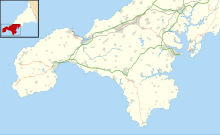Chyenhal Moor is a poorly drained shallow valley, 2 miles (3.2 km) to the south-west of Penzance, Cornwall. Due to several rare plants in a diverse range of habitats, it was notified as a Site of Special Scientific Interest (SSSI) in 1951.
| Site of Special Scientific Interest | |
 | |
| Location | Cornwall |
|---|---|
| Grid reference | SW448279 |
| Coordinates | 50°05′48″N 5°34′15″W / 50.0968°N 5.5708°W |
| Interest | Biological |
| Area | 11.9 hectares (0.12 km2; 0.046 sq mi) |
| Notification | 1951 |
| Natural England website | |
Geography
editChyenhal Moor is a poorly drained shallow valley in the parish of Paul, on the southern side of the Land's End peninsula. The small stream draining the moor flows to Kerris Moor and reaches the sea at Lamorna Cove.[1] The underlying rock is coarsely porphyritic granite and the soils are mostly humic, gleys, covered with varying depths of peat.[2]
History
editUntil the early 19th-century rough-ground such as Chyenhal Moor was an important part of the rural economy, through the grazing of livestock and cutting of furze (gorse) for fuel.[3] Moorland usually refers to uncultivated land on a hill, but locally it is also applied to wetlands such as this, and the nearby Kerris and Clodgy Moors. The high rainfall, poor drainage and acid conditions inhibit the action of bacteria which break down plant material resulting in the accumulation of a dark brown, fibrous material known as peat.[4] Chyenhal Moor has been a well known location for botany since John Ralfs (1807−1890) found rare plants here.[2]
Wildlife and ecology
editThe moor was notified as a SSSI because of the diverse range of habitats and rare plants. Willow carr is the dominant habitat, is often dense and reaches a maximum height of 5 m. It is dominated by grey willow (Salix cinerea) with some goat willow (Salix caprea) and the ground flora includes lesser spearwort (Ranunculus flammula), marsh thistle (Cirsium palustre), soft rush (Juncus effusus) and yellow flag (Iris pseudacorus). Within the willow are small patches of wet heath vegetation with Cornish moneywort (Sibthorpia europaea), wavy-leaved St John's wort (Hypericum undulatum) and ivy-leaved bellflower (Hesperocodon hederaceus). In the wetter parts are creeping forget-me-knot (Omphalodes verna), marsh pennywort (Hydrocotyle vulgaris), purple moorgrass (Molinia caerulea) and various species of moss including sphagnums.[2]
A species of note in the south-west corner of the site is pillwort (Pilularia globulifera), a rare fern of wet heathland and acid pools. Plants surrounding the pool include bog pimpernel (Anagallis tenella), marsh St John's wort (Hypericum elodes), purple moor-grass (Molinia caerulea), ragged robin (Silene flos-cuculi), scaly male-fern (Dryopteris affinis) and water mint (Mentha aquatica). A second, overgrown pond, in the south-east corner of the site has the rare unbranched bur-reed (Sparganium emersum), and a species very rare in Cornwall, ivy-leaved duckweed (Hesperocodon hederaceus). In the more open wet heathy habitats heath spotted orchid (Dactylorhiza maculata), glaucous sedge (Carex flacca) and star sedge (Carex echinata) are found. Seven species of dragonfly have been recorded including the broad-bodied chaser (Libellula depressa) and the four-spotted chaser (Libellula quadrimaculata).[2]
In the north of the site is an open-heathy area dominated by common gorse (Ulex europaeus) and heather (Calluna vulgaris). The rare Dorset heath (Erica ciliaris) was planted here in 1934.
Culture
editChyenhal Moor was the subject of paintings by two Newlyn School artists, Stanhope Forbes and Harold Harvey. Harvey's depicts the winter cutting of furze (gorse) on the moor.[3][5]
References
edit- ^ OS Explorer Map 102. Land's End (Map). Southampton: Ordnance Survey. 2005. ISBN 0 319 23703 6.
- ^ a b c d "Designated Sites View". Natural England. Retrieved 18 August 2020.
- ^ a b Dudley, Peter (Summer 2016). "Rough Ground Resources". The Land. No. 16. pp. 15–17. Retrieved 18 August 2020.
- ^ Lawman 2002, p. 56
- ^ "STANHOPE ALEXANDER FORBES (BRITISH 1857-1947) Chyenhall Moor, Cornwall". Chiswick Auctions. Retrieved 15 September 2022.
Sources
edit- Lawman, Jean (2002). A Natural History of Land's End. Padstow: Tabb House. ISBN 1 873951 40 X.
